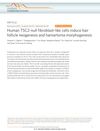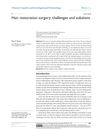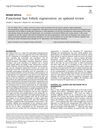TLDR TSC2-/meth cells can cause skin lesions, hair growth, and lung issues, and may be treated with chromatin remodeling agents.
The study demonstrated that primary TSC2-/meth cells, which lack tuberin due to an epigenetic event, induced follicular neogenesis and cutaneous lesions in a TSC mouse model. These cells showed high mTOR activity and localized in hair bulbs, leading to skin thickening and hair growth. Treatment with 5-azacytidine reduced hair follicles and decreased mTOR activity, suggesting its potential effectiveness on TSC lesions. Additionally, TSC2-/meth cells exhibited metastatic capabilities, migrating to the lungs and causing tissue changes. This model provided insights into the role of mTOR in TSC-related skin and hair manifestations and highlighted the potential of targeting epigenetic silencing for treatment.
4 citations
,
January 2019 in “Journal of cutaneous pathology” The mTOR pathway may be involved in the development of hair follicle tumors, with higher activity in malignant tumors.
 36 citations
,
March 2011 in “Nature Communications”
36 citations
,
March 2011 in “Nature Communications” Cells from a skin condition can create new hair follicles and similar growths in mice, and a specific treatment can reduce these effects.
22 citations
,
November 2016 in “International journal of molecular sciences” Vitamin D receptor is important for regulating hair growth and wound healing in mice.
 31 citations
,
July 2015 in “Clinical, Cosmetic and Investigational Dermatology”
31 citations
,
July 2015 in “Clinical, Cosmetic and Investigational Dermatology” Hair restoration surgery effectively treats hair loss with natural-looking results, using techniques like stem cells and platelet-rich plasma.
 42 citations
,
February 2021 in “Signal Transduction and Targeted Therapy”
42 citations
,
February 2021 in “Signal Transduction and Targeted Therapy” Hair follicle regeneration possible, more research needed.
 36 citations
,
March 2011 in “Nature Communications”
36 citations
,
March 2011 in “Nature Communications” Cells from a skin condition can create new hair follicles and similar growths in mice, and a specific treatment can reduce these effects.
8 citations
,
March 2015 in “International Journal of Oncology” Tsc2-deficient stem cells can help understand and treat TSC-related tumors.


